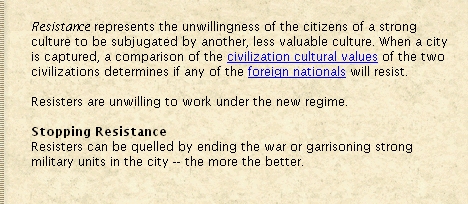Lt. 'Killer' M.
Deity
- Joined
- Dec 5, 2001
- Messages
- 7,475
Here is an excerpt from the Civilopedia on the basics of resistance:

basically, the higher the cultural difference, the more resistors - but how strong is the random influence? I find that reloading often gives a difference of 1 or even two resisters out of 2 or three in towns up to size 5. Above that to size 12, the number seems to vary by up to 3. In a metroplois, the number of resisters then varies by up tp 6
also, it is pretty simpl how to get rid of them - station military units in that town.
But what are the probabilities of success? Are several units more effective because their effect is cumulative or are they also 'helping' each other? And is there a difference in difficulty levels? To me, it seems that on Emperor resistance lingers a lot longer than in Regent, and that double the number of troops only doubles the chance of suppressing a resister, but does anyone know??????
Also, the text claims that resistance can be quelled by stopping the war - but as a recently posted screenshot with a resister from 1500 years or so ago showed this is at best party true....

basically, the higher the cultural difference, the more resistors - but how strong is the random influence? I find that reloading often gives a difference of 1 or even two resisters out of 2 or three in towns up to size 5. Above that to size 12, the number seems to vary by up to 3. In a metroplois, the number of resisters then varies by up tp 6

also, it is pretty simpl how to get rid of them - station military units in that town.
But what are the probabilities of success? Are several units more effective because their effect is cumulative or are they also 'helping' each other? And is there a difference in difficulty levels? To me, it seems that on Emperor resistance lingers a lot longer than in Regent, and that double the number of troops only doubles the chance of suppressing a resister, but does anyone know??????
Also, the text claims that resistance can be quelled by stopping the war - but as a recently posted screenshot with a resister from 1500 years or so ago showed this is at best party true....


 anyway: the more the better:
anyway: the more the better: cracker?????????
cracker????????? 